

Burke, Edmund. 1909–14. On the Sublime and Beautiful. Vol. 24, Part 2. The Harvard Classics. Glossary of Literary Gothic Terms. RADICAL. Literature Online - Browse : Criticism & Reference (Full-Text Journals) Literature Online - Criticism & Reference: Full Text. Arquitectos cántabros y construcciones escolares. Resumen Dentro del patrimonio escolar de Cantabria hemos de resaltar un importante legado de edificios de excelente factura, al que sin duda han contribuido con su buen hacer profesional un destacado número de arquitectos, tanto locales como foráneos.

Las líneas que a continuación se redactan quieren recoger esa valiosa aportación, aunque algunas escuelas actualmente hayan desaparecido o cambiado su función. En esta ocasión nos ceñiremos a los arquitectos nacidos en la región y que realizaron construcciones escolares de finales del XIX hasta la primera mitad del XX. Nos ocuparemos en otra oportunidad de las construcciones de los últimos cincuenta años. No pretendemos exponer sus biografías, que en muchos casos han sido estudiadas en sendas monografías, sino constatar la autoría del rico patrimonio escolar que proyectaron. Introducción. El palacio de Partarríu, Escenario de “El Orfanato” The Castle of Otranto. The Castle of Otranto is a 1764 novel by Horace Walpole.

It is generally regarded as the first gothic novel, initiating a literary genre which would become extremely popular in the later 18th century and early 19th century. Gothic architecture. The interior of the western end of Reims Cathedral Gothic architecture is a style of architecture that flourished during the high and late medieval period.
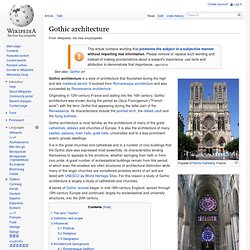
It evolved from Romanesque architecture and was succeeded by Renaissance architecture. Originating in 12th-century France and lasting into the 16th century, Gothic architecture was known during the period as Opus Francigenum ("French work") with the term Gothic first appearing during the latter part of the Renaissance.
Its characteristics include the pointed arch, the ribbed vault and the flying buttress. Strawberry Hill House. Strawberry Hill House in 2012 after restoration Strawberry Hill House, often referred to simply as Strawberry Hill, is the Gothic Revival villa that was built in Twickenham, London by Horace Walpole from 1749.
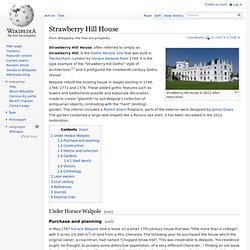
It is the type example of the "Strawberry Hill Gothic" style of architecture,[1] and it prefigured the nineteenth-century Gothic revival. Walpole rebuilt the existing house in stages starting in 1749, 1760, 1772 and 1776. These added gothic features such as towers and battlements outside and elaborate decoration inside to create "gloomth" to suit Walpole's collection of antiquarian objects, contrasting with the "riant" (smiling) garden. The interior included a Robert Adam fireplace; parts of the exterior were designed by James Essex. Uncanny. The uncanny (German: Das Unheimliche, "the opposite of what is familiar") is a Freudian concept of an instance where something can be both familiar yet alien at the same time, resulting in a feeling of it being uncomfortably strange.[1] Because the uncanny is familiar, yet incongruous, it often creates cognitive dissonance within the experiencing subject, due to the paradoxical nature of being simultaneously attracted to yet repulsed by an object.
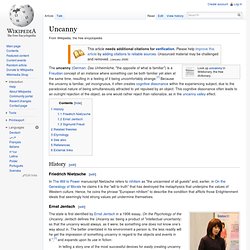
This cognitive dissonance often leads to an outright rejection of the object, as one would rather reject than rationalize, as in the uncanny valley effect. History[edit] Friedrich Nietzsche[edit] Literature Online - Criticism & Reference: Full Text. E. T. A. Hoffman. E.
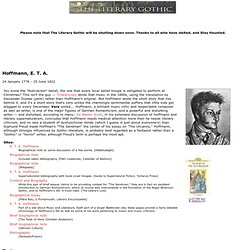
E. T. A. Hoffmann's Short Story: The Sandman. ________________________________________________Title: The SandmanAuthor: E.
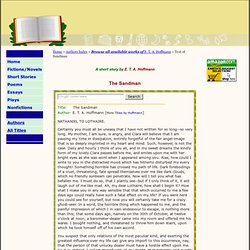
T. E. T. A. Hoffmann. Caravaggio. Baroque painting. Baroque painting is the painting associated with the Baroque cultural movement. The movement is often identified with Absolutism, the Counter Reformation and Catholic Revival,[1][2] but the existence of important Baroque art and architecture in non-absolutist and Protestant states throughout Western Europe underscores its widespread popularity.[3] The prosperity of 17th century Holland led to an enormous production of art by large numbers of painters who were mostly highly specialized and painted only genre scenes, landscapes, Still-lifes, portraits or History paintings.
Technical standards were very high, and Dutch Golden Age painting established a new repertoire of subjects that was very influential until the arrival of Modernism. History[edit] The term[edit] Francisco de Zurbarán. Francisco de Zurbarán (baptized November 7, 1598 – August 27, 1664) was a Spanish painter.
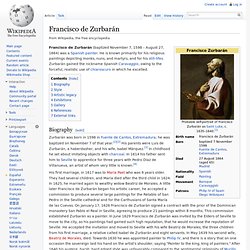
He is known primarily for his religious paintings depicting monks, nuns, and martyrs, and for his still-lifes. Zurbarán gained the nickname Spanish Caravaggio, owing to the forceful, realistic use of chiaroscuro in which he excelled. Biography[edit] Zurbarán was born in 1598 in Fuente de Cantos, Extremadura; he was baptized on November 7 of that year.[2][3] His parents were Luis de Zurbarán, a haberdasher, and his wife, Isabel Márquez.[3] In childhood he set about imitating objects with charcoal. In 1614 his father sent him to Seville to apprentice for three years with Pedro Díaz de Villanueva, an artist of whom very little is known.[4] Antonio Carnicero. Antonio Carnicero (1748–1814) was a Spanish painter of the Neoclassic style.
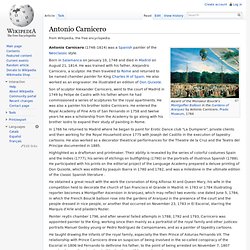
Born in Salamanca on January 10, 1748 and died in Madrid on August 21, 1814. He was trained with his father, Alejandro Carnicero, a sculptor. He then traveled to Rome and returned to be named chamber painter for King Charles III of Spain. Análisis de El Orfanato en Blu-ray - ZONADVD.com. Francisco de Goya. El Orfanato (Juan Antonio Bayona, 2007) Reseña de Sergio Checa Jociles: *El siguiente trabajo revela puntos clave de la película.

En España el cine de terror existe, tanto que ha sido y es uno de los más demandados. En estos últimos años, rara es la ocasión en la que no nos encontramos entre los listados de producciones españolas una película dedicada al gran género de terror. Eso si, no tanto como en tiempos anteriores, cuando por ejemplo entre 1971 y 1973 se llegaron a rodar 80 películas de dicho género. De esta forma la cantidad se puede establecer como superior a la cantidad global de producción en algunos años del cine español (1). Gothic fiction. Genre or mode of literature and film that combines fiction and horror, death, and at times romance The name Gothic, which originally referred to the Goths, and then came to mean "German",[2] refers to the Gothic architecture of the medieval era of European history, in which many of these stories take place. This extreme form of Romanticism was very popular throughout Europe, especially among English- and German-language writers and artists.[3] The English Gothic novel also led to new novel types such as the German Schauerroman and the French roman noir.[4] The Castle of Otranto (1764) is regarded as the first Gothic novel.
The aesthetics of the book have shaped modern-day gothic books, films, art, music and the goth subculture.[5] Early Gothic romances[edit] Entrevista con el director de El Orfanato. JSTOR: The Journal of English and Germanic Philology, Vol. 31, No. 3 (Jul., 1932), pp. 352-359.